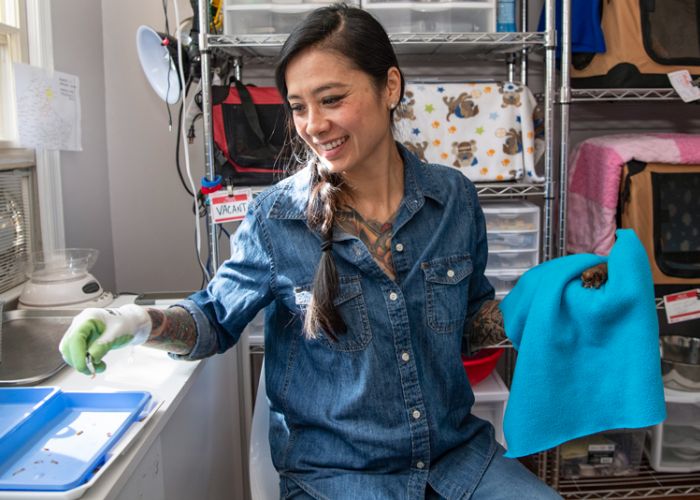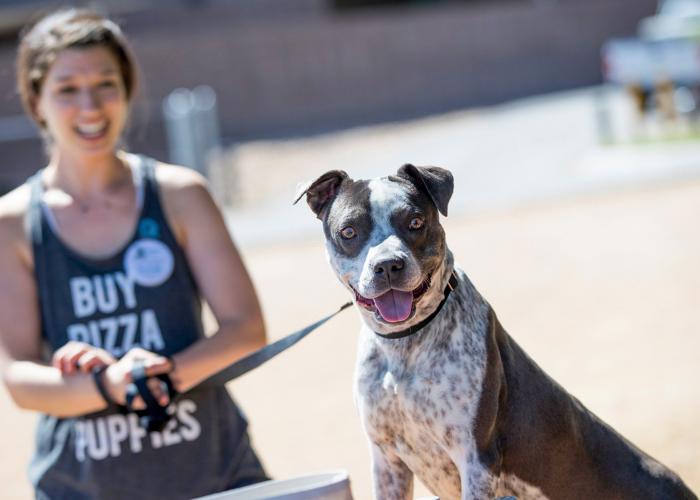Climbing the mountain
A successful capital campaign can fund a new shelter and elevate your organization to new heights

Staff and volunteers at the Lynchburg Humane Society (LHS) in Virginia got involved with the organization because they wanted to help animals, but the LHS facility was making that nearly impossible. When Makena Yarbrough joined the organization in 2009 as its first executive director, she found that the building itself was hurting the animals, especially kittens. Ventilation problems from the old, inadequate air-handling system contributed to kittens developing, and ultimately dying from, upper respiratory illness and feline distemper, Yarbrough says.
Cracking floors, rusting metal and growing mold also didn’t help the staff’s disease prevention efforts. Neither did the gaps in walls and pipes that made it easy for rodents to get in.
Built in the 1960s with poor materials, the shelter got some additions in the 1980s but was still woefully underequipped for the number of animals it took in. Overcrowding made cross-contamination from parvo outbreaks nearly impossible to contain, Yarbrough adds, and contagious dogs had to be kept in the staff bathroom (with the approval of the state veterinarian) because there was no other isolation space.
“The shelter itself was causing illness and causing stress,” says Yarbrough, who was hired by a board that was trying to change the direction of the organization for the better.
That included the building. In 2010, shelter leaders decided the old one was a lost cause and they needed a fresh start. The estimated cost for a new building was $5.6 million. After city funding (LHS serves as the shelter for Lynchburg animal control) and the organization’s own savings, LHS still needed $4.8 million. The only way to raise that money was through a capital campaign.
Yarbrough, who was previously director of operations at the Richmond SPCA and associate director at the Charlottesville-Albemarle SPCA in Virginia, had no experience with fundraising. Another challenge was the shelter’s less-than-stellar reputation in the community.And the pool of potential donors wasn’t large: Lynchburg is a rural city with a population of less than 80,000 and a poverty rate more than double the state average.
But after two and a half years of asking for major gifts, meticulously tracking and following up with solicitation calls and eventually ending with a large public marketing push, LHS not only met its goal—it exceeded it, raising $5.2 million with the help of a community leader who had never been involved in animal welfare.

Building toward success
The conditions found at the old Lynchburg building are still a reality for many shelters. But even if your shelter isn’t quite as lacking, you might outgrow your space or have to move for other reasons.
A capital campaign—a fundraising effort for a specific project (usually a building) for a set amount of money in a defined time period—is one way your organization can finance a large, out-of-the-ordinary expense like a new building. If the need is there and you do it right, you can not only raise the money needed, but come out of the campaign with enhanced community support, including more donors, volunteers and adopters.
Shelly Moore, president and CEO at the Humane Society of Charlotte in North Carolina, ran a capital campaign when she led the Asheville Humane Society—an organization she says has experienced positive effects since moving into its new building in 2010.
“They have more donors, they have more volunteers, they have more adoptions, they have more visibility,” she says. A capital campaign changes the “landscape in the community for animals.”
“The shelter itself was causing illness and causing stress.”
—Makena Yarbrough, Lynchburg Humane Society
Capital campaigns typically happen when an organization is growing, says Andrea Kihlstedt, founder and president of consulting group Capital Campaign Masters. In Lynchburg, the new building was part of a larger plan to achieve a “no-kill” community (at the time the LHS euthanasia rate was 51 percent) through spay/neuter programs, increased adoptions and a higher return-to-owner rate.
“Capital campaigns have what I refer to as a ‘springboard effect,’” says Kihlstedt. “They boost an organization’s impact, and that lets you boost the amount of money you can raise.” Plus, capital campaigns are special, infrequent efforts, so people are willing to give more, she says.
There is a strategy to capital campaigns. They’re almost scientific, says Moore—you don’t just indiscriminately ask for donations until you reach your goal. Most of the money raised will come from a few large (five- and six-figure) donations—in fact, the largest 10 to 15 gifts will likely make up 65 to 80 percent of the total amount raised, says capital campaign expert Daniel Neel, founder and president of the Fundraising Resource Group. Online gift range calculators (like blackbaud.com/nonprofit-resources/gift-range-calculator) can tell you how many gifts you need of certain amounts, based on your end goal.
“Pretty much every organization and every community has a small cluster of people who can give at the highest levels,” says Kihlstedt.
The feasibility of a feasibility study
Capital campaign experts will usually recommend doing a feasibility, or planning, study before launching a campaign. These studies assess how much money you can raise, based on factors like your available donor base, the organizational resources available to run the campaign and the community’s feelings about your organization and the project.
A feasibility study, which is often done by a third-party consultant, is equivalent to planning the design of a bridge, says Neel. “If you’re going to build a bridge, you better design it well.”
Moore has done feasibility studies for all the campaigns she’s worked on and says she wouldn’t recommend skipping them, because they provide a practice round to test your messaging with donors.
LHS, on the other hand, chose to forgo a feasibility study. It would’ve involved spending more money, says Yarbrough, and since LHS didn’t have a donor base or strong community support, “it would’ve told me that we couldn’t do it.”
That’s not to say Yarbrough didn’t plan. After LHS leaders decided they needed a new building, LHS waited almost two years before kicking off its campaign in March 2012. The time in between was spent planning and getting the organization ready.
When Good Mews Animal Foundation, a cat shelter in the Atlanta metro area, had to move after a hospital bought the shopping center it was located in, there was no time to do a feasibility study, even though consultants told them it was a worthwhile step, says board member Lori Trahan.
“For us, it was just like, ‘Well, it doesn’t really matter if it’s feasible or not; we’ve got to do it if we want the organization to survive.’”
“For us, it was just like, ‘Well, it doesn’t really matter if it’s feasible or not; we’ve got to do it if we want the organization to survive.’”
—Lori Trahan, Good Mews Animal Foundation
Good Mews still surpassed its $1 million goal, receiving all the pledges in 18 months for a predicted three-year effort, “exceeding even our consultant’s wildest imagination,” says Trahan.
Omitting the feasibility study doesn’t condemn you to failure, but doing one is a best practice. Often, planning for the campaign involves some elements of a feasibility study, like gauging donors’ interest, says Neel.
Jenny Schlueter, director of development for Tree House Humane Society in Chicago, which is finishing up the first phase of a $7-million capital campaign, says a feasibility study was helpful, but the results aren’t a guarantee. “If you can afford a feasibility study, I think it’s worth it,” she says. If not, she suggests doing your own research and reaching out to your top 50 donors to see how they’d feel about giving to your effort.

The credibility factor
Running a capital campaign is a huge undertaking, and while your shelter leaders and board of directors may be great, you’ll need to call in reinforcements. LHS had a capital campaign committee to lead the effort, made up of board members and other prominent community members who believed in the cause. The committee members made their own major donations and had enough clout in the community to solicit donations from others.
“If we get the right community leaders involved, the right resources and volunteers involved, it gives the project instant credibility,” says Neel. You want people to say, “Wow, if they’re involved … there’s something good going on there,” he adds.
“If we get the right community leaders involved, the right resources and volunteers involved, it gives the project instant credibility.”
—Daniel Neel, The Fundraising Resource Group
A godsend for LHS was the textbook-perfect chairman for its capital campaign committee. He was the recently retired CEO of the local health care system, who was “extremely connected” and had more than 30 years of business experience, says Yarbrough. He wasn’t even interested in animal welfare at first, but his wife was on the LHS board and asked him to be involved—and he’s since become a huge supporter of the organization.
It was a rocky start: “He literally told me I was crazy and that I wasn’t going to be able to raise the money that we thought we could,” says Yarbrough.
But he signed on, and his involvement brought the campaign credibility, which is paramount. No one is going to donate if they don’t think the project will be successful, says Yarbrough.
Your organization’s board members also need to give large gifts and solicit others for donations, and sometimes this process will drive changes to your board. LHS only has three of its original six board members (on a now 18-person board), because some members felt they couldn’t support the campaign.
The purpose of the campaign needs to be very clear, says Yarbrough. You’ll need to work on your case statement (the reason for the campaign) to figure out what messaging resonates with donors. Having a set monetary goal and deadline also creates credibility.
Once community members saw LHS had the support of the local heavy hitters and was running a professional, well-planned campaign, they realized the organization was serious about changing to better help the animals and the community. The public’s newfound faith in LHS would be important for the organization, especially for the last part of the capital campaign.

From private to public
Capital campaigns have a quiet, or silent, phase and a public phase. The quiet phase is when you are strategically soliciting donors, and board and committee members are asking their peers for donations. “Quiet” doesn’t mean it’s a secret, but you’re not marketing it to the general public yet. Usually you should have at least 50 percent of your goal committed before you do that, because you want to make sure you can reach your goal before asking the general public for money, says Neel.
When you go public, be creative and market the campaign with news stories, press releases, mailings, signs and social media.
LHS had an easy-to-remember campaign web address until the effort was completed (ItsAboutThePets.com), and inspired by local elections taking place, provided lawn signs for donors that said “We Gave to Lynchburg Humane’s New Building Project.”
Tree House Humane Society is marketing its capital campaign to move from an old, retrofitted Victorian house to a state-of-the-art facility as “The Real Tree House Cats of Chicago,” a parody on The Real Housewives franchise. RealTreeHouseCats.org takes viewers to a page with fun weekly “webisodes” featuring its feline shelter residents. Tree House has also partnered with local businesses; for example, it has asked bakeries to donate $1 from the sale of each cat-themed cupcake to the shelter.
Good Mews had a “ground-scooping” ceremony instead of a groundbreaking, and all donors received a commemorative litter scoop. Ideas like that helped generate excitement and success for the campaign, says Trahan.
While creativity is essential, traditional fundraising strategies also have a role. The home run that enabled LHS to surpass its goal was when a donor pledged to match the next $1 million raised. People who were still on the fence about donating “realized their money would be doubled, and they got involved,” says Yarbrough.
LHS moved into its new building in March 2015, six months after its capital campaign ended. Since then, its adoptions have increased (up about 43 percent in 2015). The euthanasia rate had already declined in the old building from 51 percent to 6 percent due to other shelter initiatives, but the new building will make it easier to sustain or further decrease that number. With a huge increase in donors and supporters, LHS now has an almost $2 million budget (up from less than $400,000), which has enabled it to hire more staff, including a development director and a director of operations.
The most exciting part, says Yarbrough, is that in the first 15 months after they moved to the new building, LHS took in close to 500 animals from shelters in surrounding counties.
“We’ve been able to help them because we have more space, and we’re doing more with adoptions, and we’ve got more community support,” she says. “People are wanting to get more involved with us now.”








